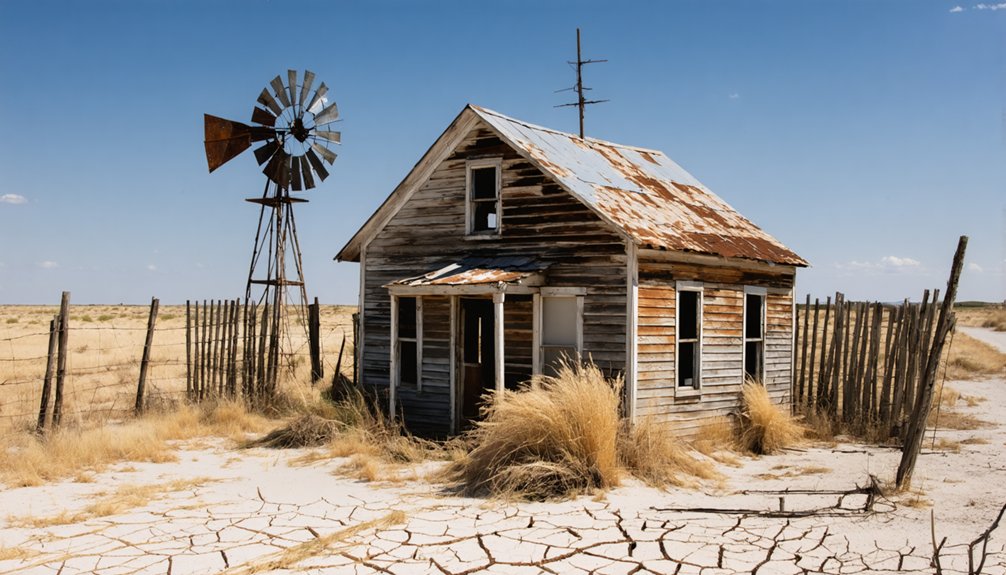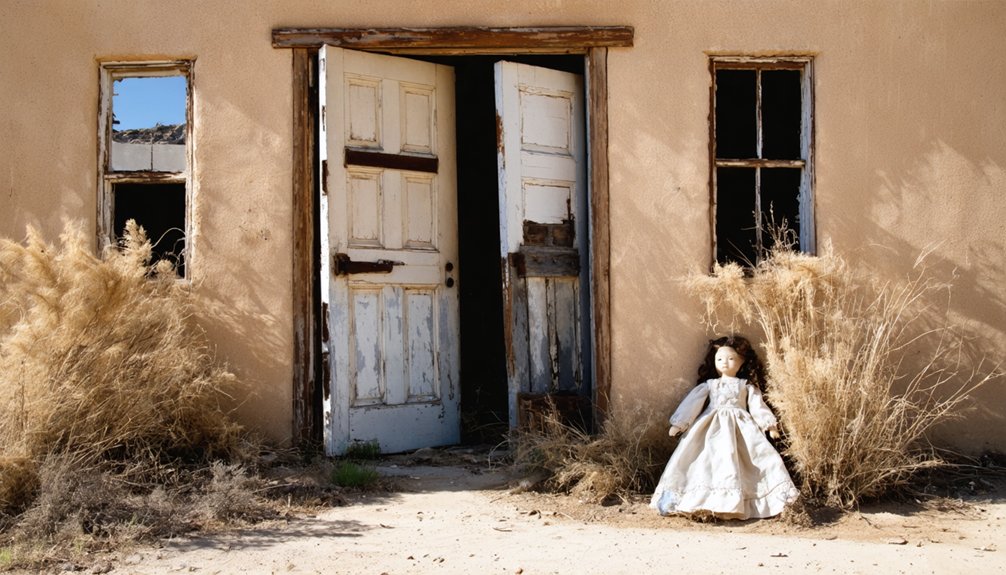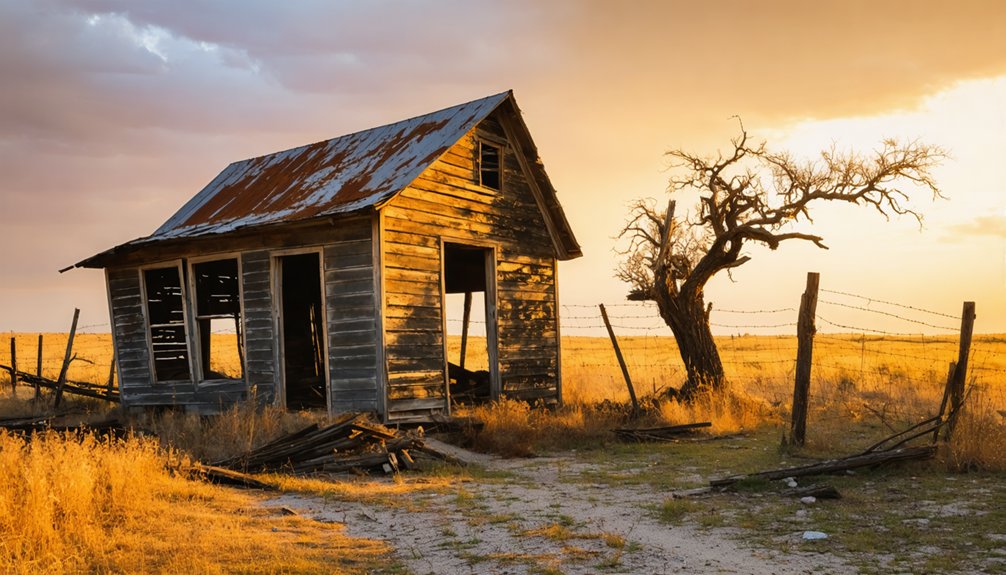Monte Christo emerged in 1909 when the Melado Land Company established an ambitious agricultural settlement in Texas’s Rio Grande Valley. You’ll find this ghost town’s fascinating history marked by rapid growth to 1,500 residents, with a bustling commercial district featuring cotton gins, hotels, and a railroad station. The town’s decline began with bandit raids between 1914-1916, while severe water scarcity ultimately sealed its fate. Monte Christo’s abandoned remnants still hold untold stories of frontier dreams and harsh realities.
Key Takeaways
- Founded in 1909, Monte Christo was a bustling agricultural town in Texas’s Rio Grande Valley that reached 1,500 residents.
- Severe water scarcity, harsh climate conditions, and poor soil quality made farming unsustainable, leading to the town’s abandonment.
- Between 1914-1916, bandit raids created instability and fear, causing many families to flee their homes and businesses.
- The town featured essential amenities including hotels, a cotton gin, railroad station, bank, and newspaper called “The Hustler.”
- Monte Christo’s historical significance is now preserved through Texas Historical Commission markers as a testament to early frontier settlement.
A Frontier Dream: The Birth of Monte Christo
While many frontier settlements emerged across Texas in the early 1900s, Monte Christo‘s founding in 1909 marked an ambitious venture by the Melado Land Company to establish an agricultural paradise in the Rio Grande Valley.
The founding vision centered on creating a thriving farming community that would draw settlers seeking new opportunities in Texas’s fertile lands. Much like the German Verein colonists who settled Indianola decades earlier, Monte Christo sought to attract immigrants to build a new life in Texas. Following the model of earlier Spanish missions, the town aimed to establish permanent agricultural settlements in the region.
You’ll find the settlement’s aspirations reflected in its very name – Monte Christo – chosen to evoke European sophistication and dreams of fortune.
Through aggressive marketing campaigns, the Melado Land Company targeted immigrants and prospective farmers, promising rich soil and abundant irrigation from the nearby Rio Grande River.
The company’s promotional materials painted a picture of a self-sustaining community where agriculture, local commerce, and careful town planning would forge a prosperous future for its residents.
Life in the Early Settlement Years
If you’d lived in Monte Christo during its early years, you’d have witnessed a bustling frontier town where settlers balanced agricultural work with community activities centered around the local school, hotels, and Virgil Lott’s newspaper “The Hustler.”
The town’s commercial district hummed with activity as farmers brought cotton to the gin, while the railroad station served as a crucial hub connecting Monte Christo’s 1,500 residents to broader markets. Early inhabitants relied heavily on prickly pear cactus as a vital food source during lean times.
Like the early Spanish settlers who established ranching near Goliad in the 1730s, your daily life would’ve revolved around the town’s key institutions, including the bank and hotels, which fostered a strong sense of community despite the challenges of frontier living.
Pioneer Daily Routines
As Monte Christo’s early settlers established their homes in the late 1800s, their daily routines revolved around the demanding cycles of agricultural work and domestic survival.
You’d rise at dawn to tend to livestock care and begin your daily chores in the cotton fields, while the women managed cooking methods using wood stoves and preserved foods.
Your farming techniques included maintaining irrigation ditches and keeping the cotton gin operational, all while battling constant water scarcity.
Community gatherings often centered around seasonal cycles of planting and harvesting, with neighbors helping neighbors during peak times.
Educational practices took place in one-room schoolhouses, though attendance varied with agricultural demands.
Resource management, especially water, shaped every aspect of your daily life, from laundry to livestock maintenance.
The local Melado Land Company managed development and land distribution, shaping the growth of the settlement during its early years.
Local news and community updates were shared through The Hustler newspaper, which kept residents informed about town developments.
Community Spirit and Culture
The platting of Monte Christo in 1909 by the Melado Land Company marked the beginning of a vibrant frontier community.
You’d have found a close-knit settlement where social cohesion centered around the local school, cotton gin, and two hotels that served as natural gathering spots for the town’s 1,500 residents.
Like the bustling mining town of Monte Cristo that once housed a thousand residents, Monte Christo showcased the pioneering spirit of early American settlements.
The local newspaper, “The Hustler,” published by Virgil Lott, kept you informed of community gatherings and daily happenings, while the railroad station connected you to the wider world.
Life wasn’t always peaceful – bandit raids and settler disputes tested the community’s resolve after 1914.
Despite these challenges, Monte Christo’s residents maintained their cultural identity through shared economic activities and social bonds until the town’s eventual abandonment in 1934.
Business and Commerce Growth
During Monte Christo’s early settlement years, commerce flourished under the guidance of Otto Woods and the Melado Land Company’s strategic development plan.
You’d find a thriving business district where economic opportunities attracted entrepreneurs and farmers alike. The town’s commercial infrastructure expanded rapidly to include essential services that supported both local needs and agricultural exports. The settlement was established in 1909 as part of a broader effort to develop South Texas farmland.
- A locally published newspaper, “The Hustler,” alongside a bank and post office, provided crucial communication and financial services.
- Two hotels and a railroad station facilitated trade connections and visitor accommodations.
- A cotton gin served as the cornerstone of agricultural commerce, processing the region’s primary crop.
When the town reached its peak population of 1,500, you’d witness a bustling economy with diverse businesses serving both residents and the farming community.
However, this prosperity wouldn’t last as water scarcity and border raids eventually undermined the town’s commercial viability.
The Rise and Peak of a South Texas Town
Founded in 1909 by the Melado Land Company, Monte Christo emerged as a promising South Texas settlement in the Rio Grande Valley, quickly establishing itself with essential infrastructure and drawing settlers to its strategic location near present-day Mission.
You’d have found a bustling community of 1,500 residents at its peak, where settlement challenges were met with determination and agricultural innovation flourished. Much like Bartonsite in 1907, Monte Christo represented the ambitious town-building initiatives of early 20th century Texas. The town boasted two hotels, a bank, a school, and “The Hustler” newspaper under publisher Virgil Lott’s direction.
A railroad station and cotton gin anchored Monte Christo’s economic foundation, while Otto Woods managed the growing townsite.
The community’s rapid development reflected the era’s optimistic spirit, with its cotton-based economy and expanding infrastructure serving both residents and travelers through the Rio Grande Valley.
Environmental Challenges and Resource Struggles

You’ll find that Monte Christo’s ultimate downfall stemmed from its persistent water scarcity, as the town’s wells struggled to provide sufficient fresh water for its growing population.
Your understanding of the settlement’s challenges must account for the harsh South Texas climate, where scorching temperatures and prolonged droughts strained both agricultural efforts and daily survival.
As you examine the town’s decline, you’ll see how the combination of inadequate water resources and extreme weather conditions proved insurmountable for the once-promising community. The situation mirrors modern challenges faced by communities like Ingleside on the Bay, where toxic pollution risks have forced residents to confront severe environmental threats to their survival.
Water Scarcity Dooms Settlement
Like many settlements in arid West Texas, Monte Christo faced an insurmountable challenge that would ultimately seal its fate: severe water scarcity. The settlement’s water management efforts proved futile as both surface water and groundwater sources proved unreliable.
Drought impact devastated the region, with critically low water levels making agriculture impossible and domestic use unsustainable. Failed irrigation infrastructure only worsened the crisis, leading to inevitable depopulation.
- Limited groundwater and surface water prevented reliable crop irrigation, destroying the settlement’s agricultural foundation.
- Inefficient water delivery systems and lack of storage infrastructure accelerated the community’s decline.
- Recurring droughts, particularly severe in the 1950s, depleted already scarce water resources beyond recovery.
These harsh environmental conditions ultimately transformed Monte Christo into another Texas ghost town, a casualty of the region’s perpetual water struggles.
Harsh Climate Tests Survival
Beyond the critical water shortages, Monte Christo’s inhabitants battled a relentless array of environmental challenges that tested their survival limits.
You’d have found your climate resilience pushed to extremes as harsh winds eroded precious topsoil, while seasonal temperature swings from scorching summers to bitter winters complicated your farming efforts.
The rocky, nutrient-poor soil beneath your feet would’ve thwarted attempts at sustainable agriculture, and survival strategies became increasingly difficult as natural resources dwindled.
You’d have witnessed the devastating impact on local wildlife as their habitats deteriorated, with species like ocelots and jaguarundis vanishing from the landscape.
Infrastructure crumbled under environmental pressures, while floods and erosion severed crucial supply routes, ultimately contributing to Monte Christo’s abandonment.
Security Threats and Border Town Violence
While crime rates in Texas border towns remain relatively low compared to many U.S. cities, the Monte Christo area faces complex security challenges stemming from cartel operations and hazardous migrant crossings.
The security dynamics have transformed dramatically as the Juárez Cartel controls key crossing points, turning human smuggling into a sophisticated criminal enterprise.
You’ll find cartel influence extending beyond the immediate border, with organized networks of “coyotes” charging thousands per migrant and positioning lookouts across mountain peaks.
- Border Patrol’s enforcement strategies have inadvertently pushed crossings into more dangerous terrain, resulting in increased migrant deaths.
- Sophisticated smuggling operations utilize storm drain tunnels and other clandestine methods to evade detection.
- Despite regional challenges, local law enforcement maintains relatively safe conditions, with violent crime rates lower than many interior U.S. cities.
The Exodus and Abandonment

Despite its promising beginnings as a thriving settlement of 1,500 residents, Monte Christo’s existence proved fleeting as dual crises gripped the town in the early 20th century.
The primary exodus reasons emerged between 1914 and 1916, when bandit raids along the border created an atmosphere of fear and instability. You’d have witnessed families abandoning their homes and businesses as the violence disrupted daily life and commerce.
The community decline accelerated when water scarcity became an insurmountable challenge. Without reliable water infrastructure, agriculture faltered and domestic needs went unmet.
Legacy and Historical Significance Today
Today, Monte Christo’s physical remnants may have vanished, but its historical legacy endures through careful preservation efforts and educational initiatives.
You’ll find its story commemorated by a Texas Historical Commission marker near Mission, Texas, serving as an essential component of the region’s cultural heritage. The ghost town’s history offers significant insights into early 20th-century settlement patterns and the challenges that shaped frontier communities in the Rio Grande Valley.
- The site serves as a living classroom for understanding water resource management, economic dependencies, and security challenges in early Texas settlements.
- Historical preservation efforts focus on educational signage and maintaining the marker site, making Monte Christo’s story accessible to future generations.
- Local historians and researchers continue to study Monte Christo’s rise and fall, contributing to broader ghost town studies across Texas.
Frequently Asked Questions
What Happened to the Buildings and Structures After Monte Christo Was Abandoned?
You’d be hard-pressed to find any remains today – building deterioration claimed most structures through decay, while salvagers likely dismantled others for materials, with no historical preservation efforts saving them.
Were There Any Attempts to Revive or Resettle Monte Christo After 1934?
Despite resettlement efforts by the Monte Cristo Preservation Association in 1983, you’ll find no successful community initiatives to revive the town. Natural barriers, poor infrastructure, and harsh conditions prevented any permanent reoccupation after 1934.
How Did Property Ownership Transfer After the Town Became Abandoned?
When the writing was on the wall, you’d find property deeds often reverted to Hidalgo County through tax foreclosures, while abandoned land was either consolidated or acquired by private buyers through auctions.
What Were the Exact Routes of the Bandit Raids Targeting Monte Christo?
You’ll find the bandits’ main routes followed railroad corridors from south and southeast, using coordinated multi-directional raid tactics. They’d split into groups, attacking simultaneously along rail lines toward Monte Christo’s defenses.
Did Any Original Monte Christo Families Maintain Ties to the Area?
Like dust in the wind, you’ll find no lasting family connections were maintained. Historical records show original families abandoned Monte Christo completely by 1934, with no documented descendants keeping ties afterward.
References
- https://ghostlandia.media/2022/12/09/fires-floods-and-avalanches-at-the-monte-cristo-ghost-town/
- https://atlas.thc.texas.gov/Details/5215004836
- https://discovertexasoutdoors.com/places/monte-christo-texas-a-ghost-town-built-on-big-dreams-and-harsh-realities/
- https://en.wikipedia.org/wiki/List_of_ghost_towns_in_Texas
- https://www.youtube.com/watch?v=8cjzuXE1Mn4
- https://durangotexas.blogspot.com/2025/08/remembering-mountain-loop-ice-caves.html
- https://www.tshaonline.org/handbook/entries/monte-christo-tx
- https://www.wearecousins.info/2013/09/monte-christo-historical-marker-hidalgo-county-texas/
- https://kfyo.com/indianola-erased-from-existence/
- https://www.texasalmanac.com/articles/the-spanish-missions-in-texas



